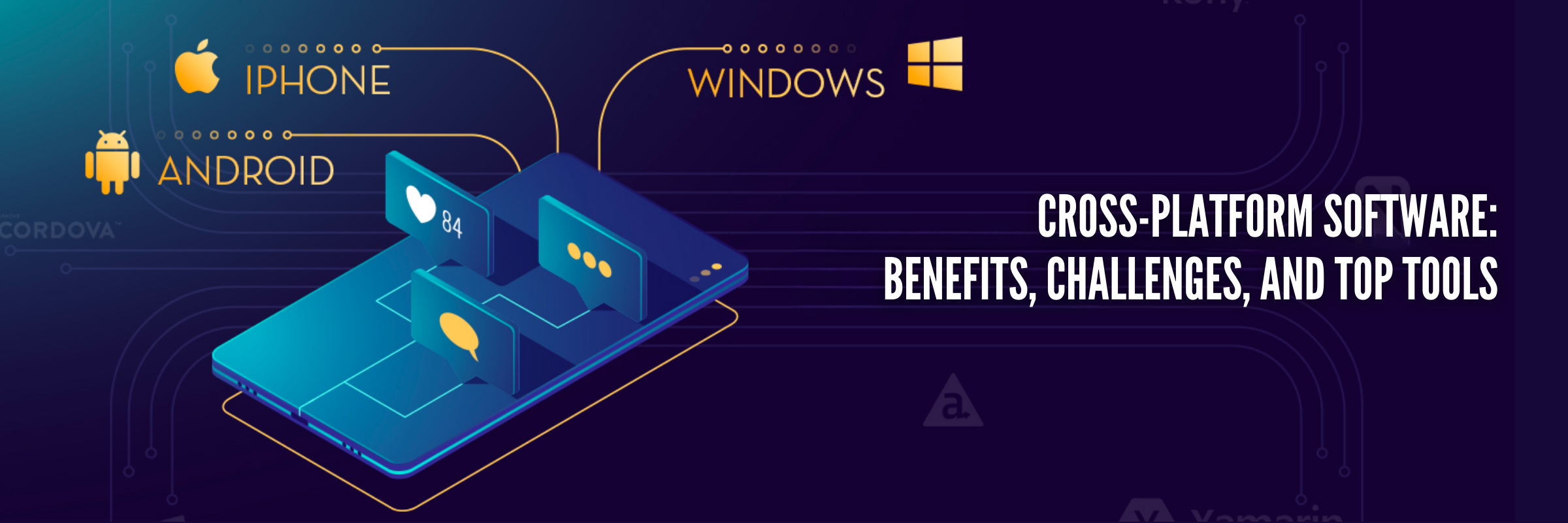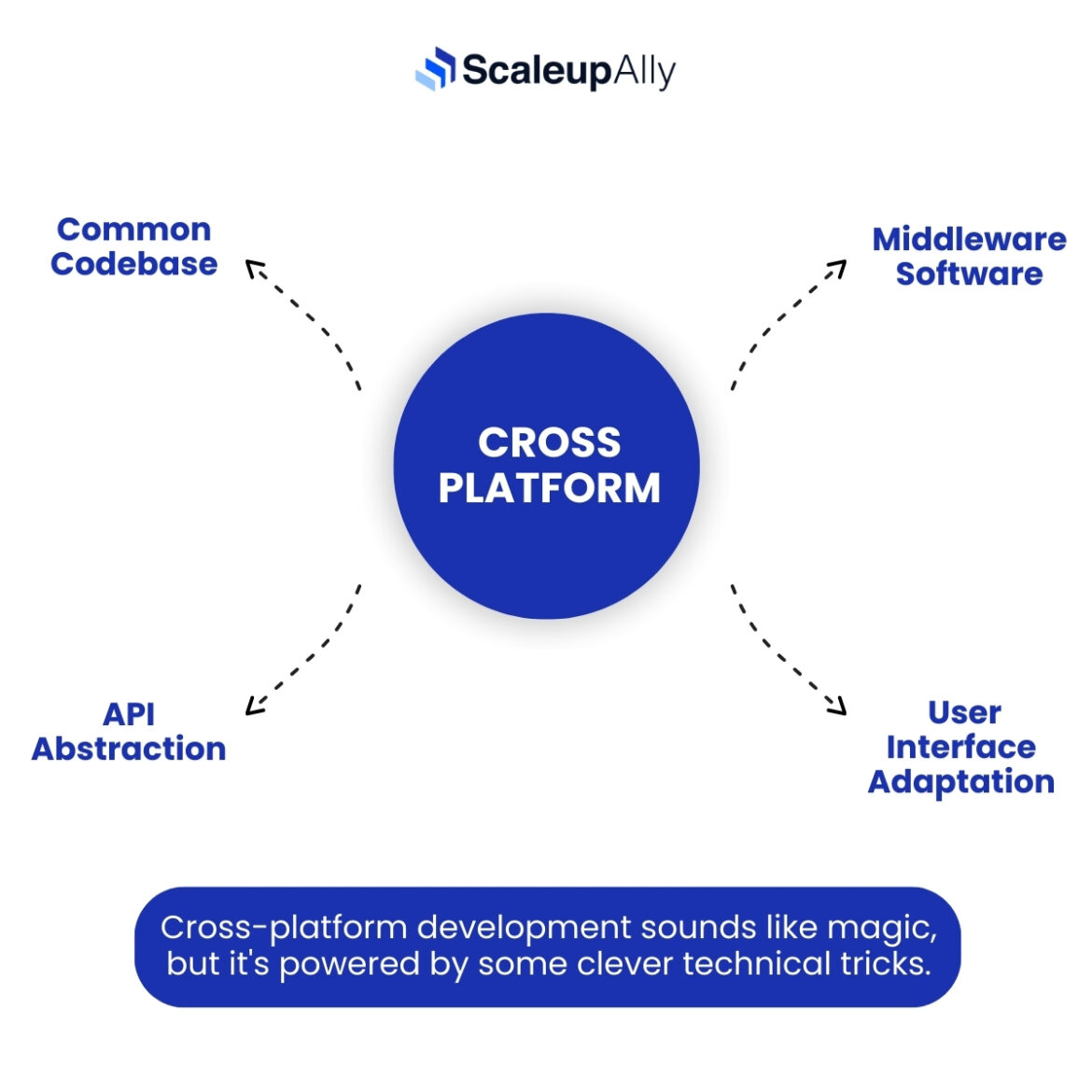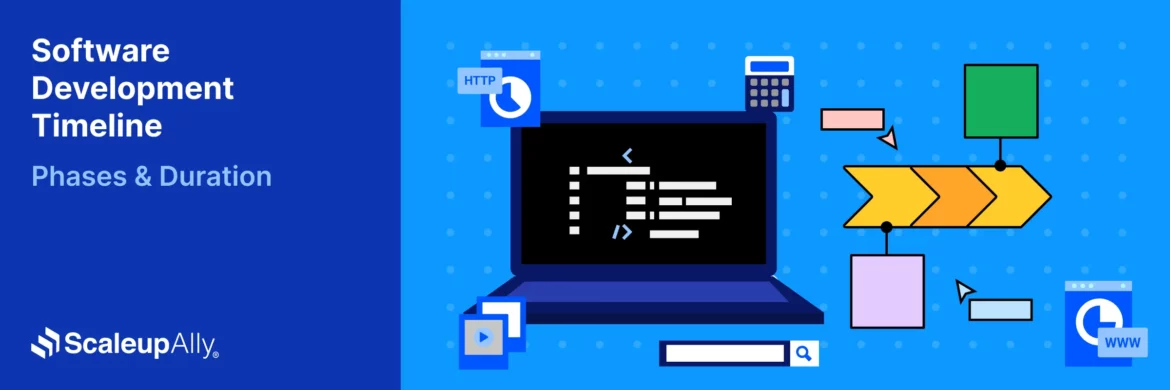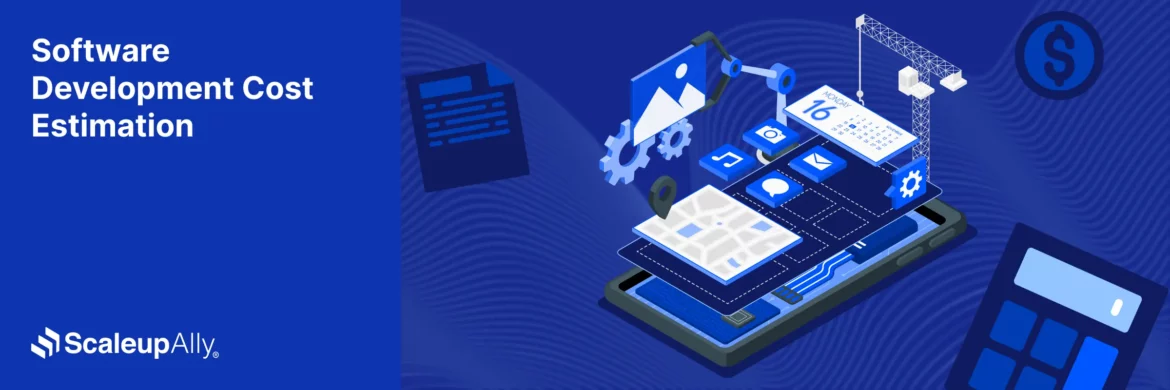
Cross-Platform Software: Benefits, Challenges, and Top Tools
Suprabhat Sen | June 24, 2024 , 14 min read
Table Of Content
Imagine a world where you code once and your code works on every device. No more creating separate versions for iOS, Android, Windows, and more. That’s the promise of cross-platform software development . But is it really that simple? In this blog post, we’ll explore the exciting benefits, the hidden challenges, and the best tools to make your app a universal success. So, get ready as we reveal the magic (and maybe a few surprises) of building software that works everywhere!
Key Takeaways
- Cross-platform development enables faster time-to-market and cost savings by leveraging a single, reusable codebase across devices.
- Businesses can expand their reach by delivering apps seamlessly on iOS, Android, and desktop platforms without extra effort.
- Maintenance becomes easier and more efficient, with updates applied once and instantly reflected across all supported platforms.
- Despite advantages, performance gaps and limited access to device-specific features can affect critical, high-demand applications.
- Choosing the right framework is vital, as long-term reliance may create challenges with flexibility, customization, and scalability.
What is Cross Platform Software?
- What is Cross Platform Software?
- How Cross-Platform Technology Works?
- Cross-Platform Vs. Hybrid Software Development
- Benefits of Cross-Platform Software
- Cons of Cross-Platform Software
- 5 Top Software Built on Cross-Platform Methodology
- Hire ScaleupAlly For Developing Your Cross-Platform Software
- Conclusion
- Frequently Asked Questions (FAQs)

Cross-platform software refers to applications, programs, or systems designed to run on multiple operating systems or platforms. This type of software can operate on different types of devices and operating systems without needing to be rewritten or significantly altered for each one.
Envision you’ve created an amazing mobile game that’s super fun and you know people would love. But there’s a problem: do you make one version for iPhone users and another for Android users? This is where cross-platform software helps.
Cross-platform software is like a universal translator for your game. It’s designed to work on different operating systems, like Windows, macOS, Android, and iOS. Think of an operating system as the language your device speaks. Cross-platform software lets your game speak all these languages, so it can run smoothly on any device. Cross platform, means anything that is designed to work across different platforms or systems.
Cross-platform software ensures that applications can reach a wider audience by functioning on multiple devices and operating systems. This broad accessibility is crucial in today’s world, where users often switch between different devices.
Also Read: How To Build a Cross Platform Mobile App?
How Cross-Platform Technology Works?
Cross-platform development sounds like magic, but it’s powered by some clever technical tricks. Let’s explore the key components that make it all work:
1. Common Codebase
A common codebase is a unified set of code that can be executed on different platforms without needing to be rewritten for each one. This is typically achieved using languages and frameworks that support cross-platform development. Languages like JavaScript (React Native) or Dart (Flutter) are popular choices for this role.
2. Middleware Software
This is the bridge between your common code and the specific operating system. It acts as a translator, taking the instructions from your code and converting them into a format the particular device understands. Popular middleware options include Xamarin and React Native.
3. API Abstraction
Apps interact with a device’s features like the camera or GPS through APIs (Application Programming Interfaces). The challenge is, these APIs can differ between operating systems. Here, abstraction comes in. The cross-platform framework provides a unified layer that hides the complexities of these individual APIs.
4. User Interface Adaptation
While the core functionalities can be shared, the look and feel (UI) of an app needs to adapt to each platform. Cross-platform frameworks often provide UI components that can be customised to match the native look and feel of each operating system. Some frameworks even allow developers to write platform-specific UI code if a truly unique experience is desired. For example, React Native allows developers to use platform-specific components (like ‘ActivityIndicator’ for Android and ‘UIActivityIndicatorView’ for iOS) while maintaining a common structure. Flutter uses a widget-based approach to create adaptive UIs.
Working together, these elements allow developers to create a single codebase that can be deployed across various platforms, making the development process faster and more cost-effective. It’s not always perfect, but it’s a powerful tool for reaching a wider audience without sacrificing too much on user experience.
Cross-Platform Vs. Hybrid Software Development
Here’s a concise comparison between Cross-Platform and Hybrid Software Development. This table highlights the key distinctions to help you choose the right approach based on project requirements.
| Feature | Cross-Platform Development | Hybrid Software Development |
| Definition | Builds apps using a single codebase for multiple OSs | Combines web technologies (HTML, CSS, JavaScript) within a native wrapper |
| Frameworks | React Native, Xamarin, Flutter | Ionic, Apache Cordova |
| Performance | Near-native performance, more optimised | Slower performance due to web view dependencies |
| Access to Native Features | Extensive access to native APIs | Limited access, often reliant on plugins |
| User Interface | Native UI components for better platform consistency | Web-based UI, may not fully match native look |
| Development Time | Generally faster, one codebase | Rapid prototyping is possible but may need adjustments to polish |
| Use Case | Apps needing near-native performance and look | Apps focusing on broad reach with less intensive performance needs |
Benefits of Cross-Platform Software
Cross-platform software offers several significant benefits, making it an attractive choice for many developers and businesses. Let’s explore these benefits:
1. Cost-Effectiveness
Imagine you’re creating a software product and want it to reach a lot of people. Instead of making different versions for each type of device (like phones, tablets, and computers), you can use cross-platform development. This means you write the code once, and it works on all types of devices. It saves time and money because you don’t have to make and maintain multiple versions. This lets businesses launch their products quicker and more cost-effectively.
2. Wider Market Reach
Gone are the days of limiting your software’s reach to a single platform. Cross-platform development shatters these boundaries, allowing you to cast a wider net and capture a much larger audience. Whether your target users are on Android, iOS, Windows, or macOS, a cross-platform approach ensures your software is readily available to them, maximising your potential user base.
3. Faster Time to Market
Cross-platform development makes it faster to create software because you don’t have to make separate apps for different platforms. This speed is important in the fast-changing tech world. It helps you take advantage of market opportunities and meet user needs before others. Being faster can give you a big advantage over competitors.
4. Simplified Maintenance
Maintaining a single codebase is a breeze compared to juggling multiple versions for each platform. Cross-platform development eliminates the need for platform-specific updates and bug fixes, streamlining the maintenance process. This translates to lower ongoing costs and frees up development resources for future enhancements and innovation.
5. Consistent User Experience
Users expect a seamless and consistent experience across all the devices they interact with. Cross-platform development helps ensure a familiar look and feel for your software, regardless of the platform it’s running on. This consistency fosters brand recognition and builds user trust, leading to a more positive and engaging user experience.
6. Reduced Risk
The tech world is always changing, which can be tricky to navigate. Using a single codebase for cross-platform development can help reduce the risk of running into problems with specific platforms or unexpected changes in the industry. This means your software is less likely to become outdated because of limitations on certain platforms.
By using cross-platform development, you can simplify how you create apps and reach more users, helping you build a strong market presence. However, it’s important to keep in mind that there are some challenges, which we’ll discuss next.
Cons of Cross-Platform Software
While cross-platform software offers many advantages, it also has some drawbacks that developers and businesses should consider. Here’s a peek at the potential hurdles you might encounter:
1. Performance Considerations
While cross-platform apps strive to deliver a near-native experience, they may not always achieve the peak performance of native apps. This can be a critical factor for applications that deal with intensive tasks or require lightning-fast responsiveness. For instance, a graphics-heavy game or a stock trading app might see a slight drop in performance compared to its native counterparts.
2. Limited Access to Native Features
One of the trade-offs of cross-platform development can be restricted access to certain device-specific features or functionalities. Imagine a fitness app that can’t use the latest health sensors on a particular phone, or a camera app lacking advanced controls available on a specific platform. These limitations can hinder the app’s ability to fully compete with native apps that can exploit the device’s complete potential.
3. The UI
Achieving a truly native look and feel across all platforms can be a tightrope walk. While some frameworks offer UI customization tools, perfectly mirroring the nuances of each platform’s design language can be challenging. Users accustomed to a specific platform’s interface might notice a subtle disconnect, impacting the overall user experience.
4. Debugging
Cross-platform development introduces additional layers of complexity compared to native development. With the codebase, middleware, and platform all playing a role, troubleshooting issues can become a more complex maze to navigate. Isolating the source of a problem can take more time and effort compared to debugging a native app.
5. Framework Lock-in
Choosing a cross-platform framework is a commitment. Your app becomes reliant on the functionalities and limitations of that particular framework. While some frameworks offer a high degree of flexibility, switching frameworks later can be a significant undertaking, requiring substantial rework of the codebase.
6. Not a Universal Solution
The allure of cross-platform development can be strong, but it’s important to remember it’s not a one-size-fits-all solution. Complex applications with a heavy dependence on specific device features, or those requiring truly unparalleled performance, might be better suited for the more traditional route of native development. For instance, professional video editing software might be better served by the granular control and optimization offered by native development.
By understanding these challenges and how they relate to your project, you can decide if cross-platform development is best for your software. It’s about balancing development speed, accessibility, and user experience.
5 Top Software Built on Cross-Platform Methodology
Cross-platform development has become a powerful tool for creating popular and versatile software applications. Let’s look at five examples that demonstrate how effective this approach can be.
1. Airbnb (React Native)
The world’s leading accommodation marketplace relies on React Native for its mobile app. This allows travellers to effortlessly search for and book stays across a vast range of devices, contributing to Airbnb’s global reach and user base.
2. Instagram (React Native)
This social media giant uses React Native for its mobile app, allowing users to share photos and connect with friends seamlessly across Android and iOS devices. The cross-platform approach ensures a consistent experience while enabling rapid development for new features and updates.
3. Pinterest (React Native)
The go-to platform for visual inspiration, Pinterest, employs React Native for its mobile app. This allows users to explore, save, and share ideas across various devices, fostering creativity and inspiration regardless of platform limitations.
4. Facebook (React Native)
Meta, formerly known as Facebook, created React Native and used it to build their Facebook app. Initially conceived as a project during a hackathon, React Native now forms the foundation of most of the company’s applications.
5. UberEats
UberEats is an app with three main components: one for restaurants, one for consumers, and one for delivery partners. To efficiently develop and maintain these dashboards, Uber needed a fast solution.
Originally, UberEats was primarily a web-based platform built with React. Due to limited experience in iOS and Android development, they opted to use React Native for the mobile dashboard. The team found the transition to React Native to be a positive one.
These are just a few examples of the many successful software applications built on cross-platform methodologies.
Hire ScaleupAlly For Developing Your Cross-Platform Software
If you’re considering developing cross-platform software, ScaleupAlly could be an excellent choice. As an IT team specialising in custom software development, ScaleupAlly has 50+ engineers ready to bring your project to life. Here are some reasons why you might want to consider hiring ScaleupAlly for your cross-platform software development needs:
- Expertise: ScaleupAlly has a team of experienced professionals who are well-versed in cross-platform development frameworks and technologies, ensuring that your software is built to the highest standards.
- Time-Efficient: ScaleupAlly’s efficient development processes can help you get your software to market faster, allowing you to capitalise on opportunities sooner.
- Scalability: ScaleupAlly can help you build scalable software solutions that can grow with your business, ensuring that your software remains relevant and effective in the long run.
- Support: ScaleupAlly provides ongoing support and maintenance for your software, ensuring that it remains up-to-date and secure.
Hiring ScaleupAlly for your cross-platform software development needs can be a smart choice, offering you a cost-effective, efficient, and scalable solution that meets your requirements.
Conclusion
Cross-platform software development is a way of developing apps that work on different devices like phones and computers. It’s great because it saves time and money by using the same code for all platforms. This means apps can be made and updated faster.
- With cross-platform development, apps can reach more people because they work on different devices. This makes it easier for users to recognize and trust the app.
- Maintaining apps is also easier with cross-platform development because there’s only one version of the code to manage.
However, there are some challenges. Cross-platform apps might not perform as well as apps made specifically for one platform. Some features may also be limited, and making the app look and feel the same on all devices can be tricky.
Deciding between cross-platform and platform-specific development depends on what your app needs. If you want to save money and reach more people quickly, cross-platform is a good choice. But if you need top performance or special features for specific devices, platform-specific might be better.
In conclusion, cross-platform development is a useful tool, but it’s not always the best choice. Think about your app’s needs and your audience before deciding. Understanding the pros and cons of each approach will help you make the right decision for your app.
Frequently Asked Questions (FAQs)
Q: What are cross-platform applications?
Cross-platform apps are software programs that work on multiple operating systems (Android, iOS, Windows, etc.) They’re built with a single codebase, allowing for wider reach and faster development.
Q: What’s the difference between cross-platform and single platform software?
Cross-platform apps work on multiple platforms using one codebase. They offer wider reach but may have limitations in performance and features. Single-platform apps (native) are built specifically for one system (e.g., Android) and can leverage all its features and performance, but require separate codebases for different platforms.
Q: What’s the best cross-platform framework?
There’s no single “best” framework. Popular options include React Native (easy to learn, large community), Flutter (high performance, beautiful UI), and Xamarin (mature, feature-rich for enterprise). The best choice depends on your project’s needs and your development team’s skills. Consider factors like supported platforms, programming languages, performance requirements, and available resources.
Related Blogs

Software Development Timeline: Phases, Duration & Estimation Guide
Understand the software development timeline with phase durations, key factors, hidden delays, and practical methods to estimate project time.
Suprabhat Sen
Nov 29 ,
16 min read

Software Development Cost Estimation Guide: What’s Included & What Affects the Price
Explore software development cost components, major pricing factors, and practical estimation methods to plan your project accurately from start to finish.
Suprabhat Sen
Nov 29 ,
14 min read

Calculating ROI for Software Development: A Detailed Guide
Discover proven strategies and practical tips to enhance the ROI for software development projects. Learn how to measure success and increase profitability.
Manu Jain
Nov 25 ,
19 min read


